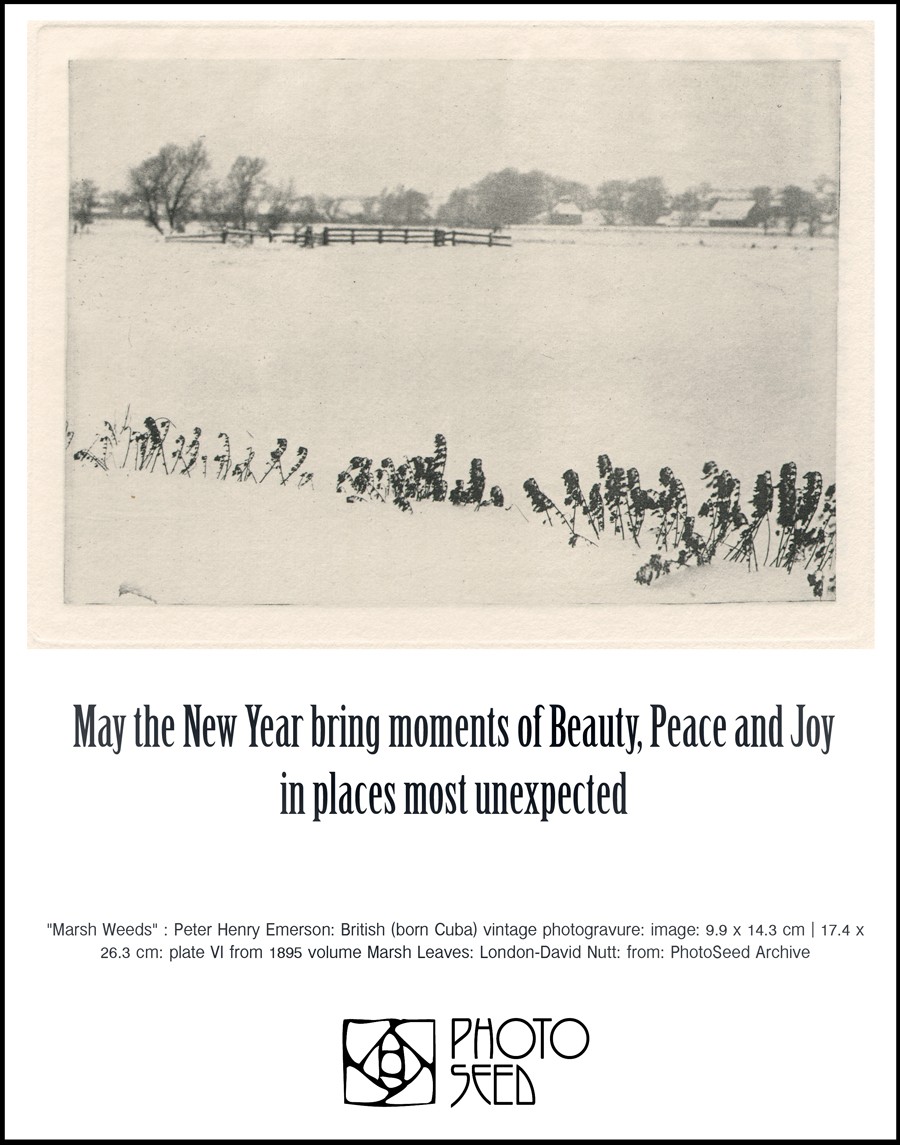
.

.
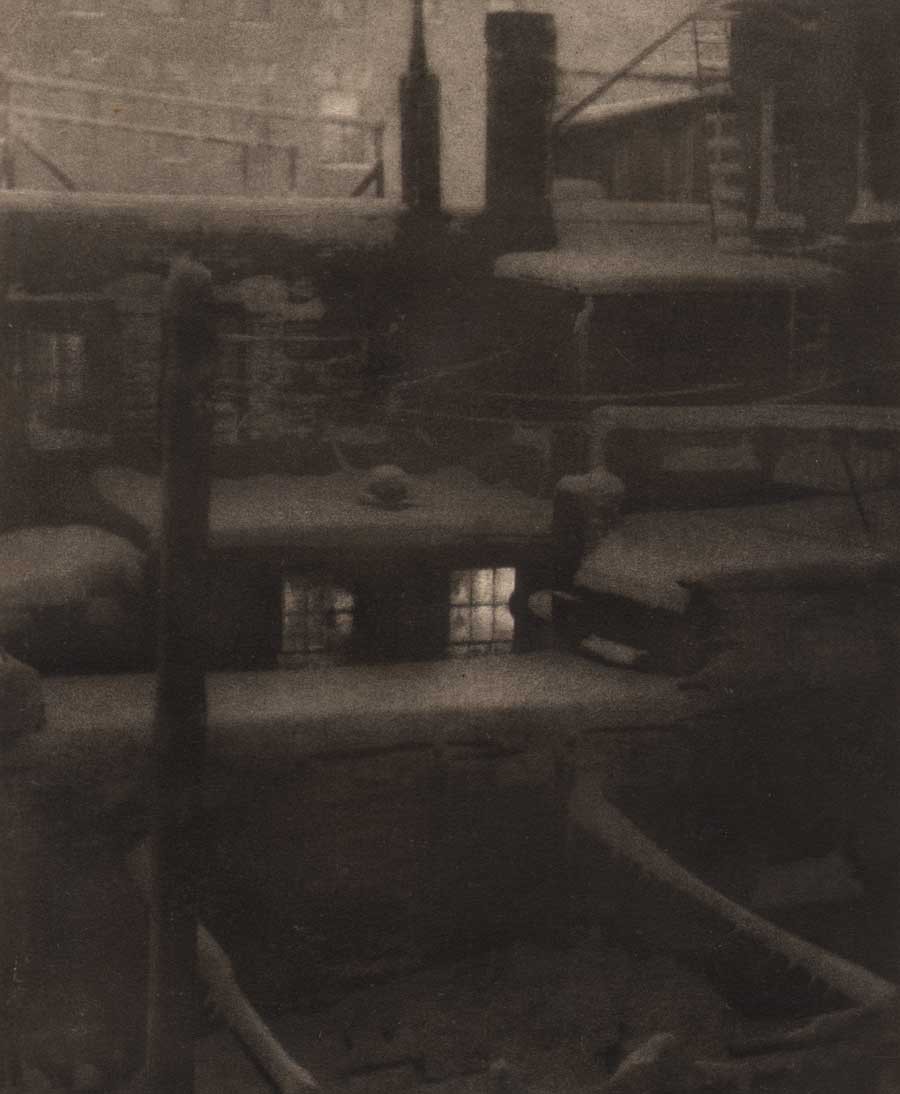
Detail: “Thru the Back Window”: Charles A. Hellmuth: American: vintage 1924 Wellington bromoil print: 32.1 x 24.0 cm | 50.7 x 40.6 cm: from: PhotoSeed Archive
This spooky season. For more on this photograph with a short overview on the pictorial work of Maine resident Bertrand H. Wentworth, proceed here.
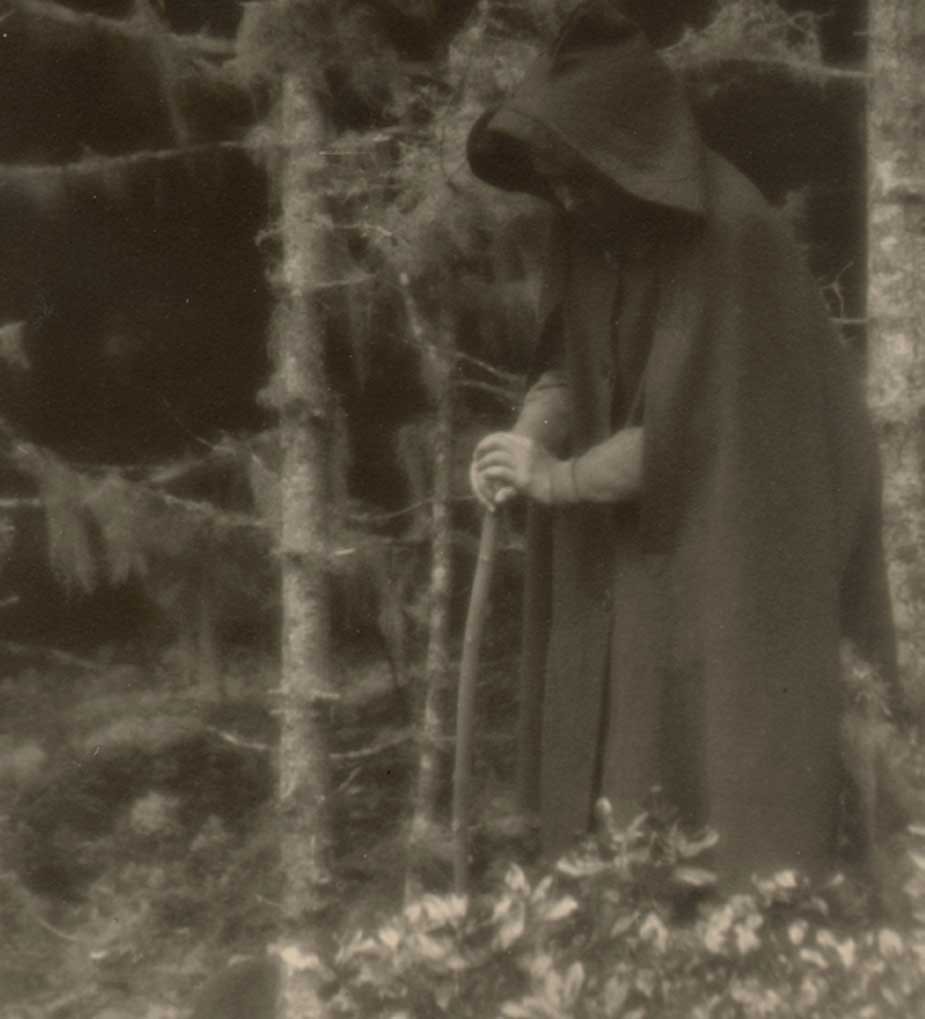
Detail: Bertrand H. Wentworth: American: “Witches’ Wood” : (34.9 x 27.1 cm) : vintage gelatin silver print: ca. 1915-20. Perhaps showing the photographer himself dressed as a witch, locations used by Wentworth for his photographs were described in the Oct., 1919 issue of The American Magazine of Art: “The sea, the pine woods, winter landscapes, he has made his specialty, and the majority of his themes he has found in the vicinity of his home at Gardiner, Maine.” from: PhotoSeed Archive
With Autumn upon us in the more seasonal regions of the United States, a remembrance, particularly if we are young, of the joys of cooling off in the lakes, ponds, and rivers of our youth.
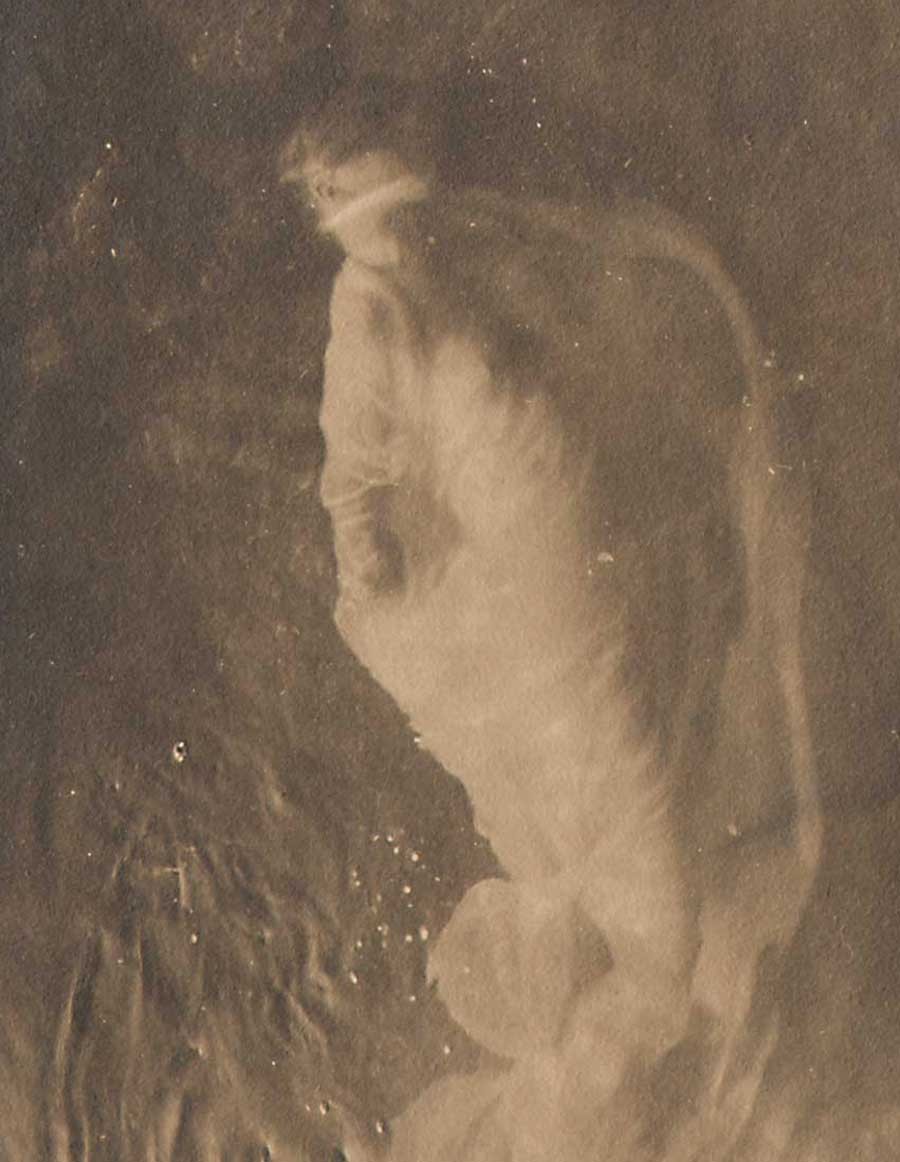
Detail: Gelatin silver print: “Mermaid Study : Ki-lo-des-ka”: ca. 1914 or before: by Charlotte Vetter Gulick: image: 7.1 x 9.2 cm: mount: 16.7 x 22.7 cm. Subject shows Katharine “Kitty” Gulick swimming underwater at Camp Wohelo in Maine. from: PhotoSeed Archive
Memories made all the more indelible if we ever had the opportunity to attend summer camp.
So lets go further and think about taking a photograph of someone underwater. Not a photo taken with a camera underwater, a remarkable feat in itself accomplished beginning in 1893 by the Frenchman Louis Boutan, (1.) but from the outside looking in.
Before researching a series of photographs recently acquired for this archive showing a young woman swimming underwater, I would have thought no big deal- perhaps they were rare but could the subject matter actually be unique? After all, they were first published for a mass audience in Everybody’s Magazine in the U.S. in August of 1914, with the author exclaiming them to be “remarkable photographs…taken under conditions not easily duplicated, and have aroused great interest among artists and others who have seen the originals.” (2.)
No doubt other examples of this activity exist in the form of vintage photographs. Snapshots perhaps-but ones where actual intent existed in order to show the beauty of the human figure swimming underwater? Before or perhaps a decade or two after 1914? Somehow I doubt it.

Three individual halftone and letterpress page spreads showing mermaid “Ki-lo-des-ka” (Katharine “Kitty” Gulick) swimming and lying submerged underwater: from: Everybody’s Magazine: New York: August, 1914: pp. 225-232
With a bit of research, I not only discovered the subject of the “mermaid” doing the swimming in the photos: Katharine “Kitty” Gulick, (1895-1968) but the remarkable story behind the amateur photographer who took them: her mother Charlotte Vetter Gulick. (1865-1928) Taken at Wohelo girls summer camp on the shore of Sebago Lake in Raymond, Maine, a camp founded in 1907 by Gulick and husband Luther Halsey Gulick (1865-1918) that is still going strong today, the following article from Everybody’s explains how these remarkable photos were taken and provides guiding principals behind the Camp Fire Girl movement founded by the photographer herself.

inset: detail: Gelatin silver print: “Mermaid Study : Ki-lo-des-ka” ca. 1914 or before: by Charlotte Vetter Gulick: image: 8.1 x 10.5 cm: mount: 16.8 x 23.2 cm: This was an early effort showing “Kitty” wearing a dark-colored bathing-suit “which was too nearly the tone of the rocks to give definition” before the garment was substituted for “a flowing garment of cheese-cloth” which showed up much better against the darkness of the water.: from: PhotoSeed Archive. Background: Camp Wohelo Indian symbol for “Ki-lo-des-ka” aka: “Water-bird”: from 1915 volume by Ethel Rogers: “Sebago-Wohelo Camp Fire Girls”
Illustrating the article were eight photographs of Wohelo camper “Ki-lo-des-ka“, or “Water-bird“, the aforementioned “Kitty” Gulick, with several of the originals formerly owned by her appearing with this post:
The Mermaid
A SERIES OF PHOTOGRAPHS BY MRS. LUTHER HALSEY GULICK
THESE remarkable photographs are instantaneous pictures of a young girl swimming under water. They were taken under conditions not easily duplicated, and have aroused great interest among artists and others who have seen the originals. The photographs were taken by Mrs. Luther Halsey Gulick at her private summer camp for girls on Sebago Lake, Maine. The subject was a girl who possessed the unique accomplishment of being able to swim under water as far as one hundred feet. By a long under-water swim the ripples caused by her plunge had plenty of time to die out before she passed the rock on which Mrs. Gulick stood with the camera.
The experiments were made on a brilliantly clear day. The water also was extraordinarily clear and the swimmer passed the camera’s field two or three feet below the surface. The final clue to success was found when a flowing garment of cheese-cloth was substituted for the dark-colored bathing-suit, which was too nearly the tone of the rocks to give definition. Both the figure and the draperies, under the equalizing buoyancy of the water, give a rare representation of poise, as they are entirely unaffected by the force of gravity.
How far short this description fails of conveying the art value of the photographs, their rhythm of line and beauty of form and tone, is significantly obvious; for in this margin of appeal to the imagination lies the motive that produced the pictures. They were taken at the birthplace of the Camp-Fire idea of which Mrs. Gulick is one of the chief sponsors.

Detail: Gelatin silver or Bromide print: “Mermaid Swimming” (“Ki-lo-des-ka”) ca. 1914 or before: by Charlotte Vetter Gulick: image: 8.7 x 11.2 cm: mount: 16.5 x 22.9 cm: reproduced as opening photo for article “The Mermaid” A SERIES OF PHOTOGRAPHS BY MRS. LUTHER HALSEY GULICK: in Everybody’s Magazine: New York: August, 1914: p. 225: note: hair at center of frame result of negligence from contact-printing from original negative. from: PhotoSeed Archive
The photographs are a suggestive interpretation of the first law of the Camp-Fire, “Seek beauty;” a revelation of the poetic side of one of the simple, wholesome, normal acts of life. This is the principle, full of possibilities yet undeveloped, upon which the Camp-Fire ceremonial and symbolism are based.
The first ideal of the Camp-Fire girl is the development of a well proportioned physique; a body under perfect control and responsive to every call of the spirit within. Her other ideals include an all-around training in the art of home-keeping in the modern sense, which involves a knowledge of community conditions as well as of the simple processes of home activity. This points to the further ideal of patriotism in the sense of loyalty to country, to church, to humanity, and of service in its broadest meaning.
But to hold forth these aims and say “These are the Camp-Fire” would be as inadequate as to inscribe beneath these rarely beautiful photographs the legend, “A Girl Swimming,” and consider the story told. The Camp-Fire girl makes an art of living. She finds in the mystic glow of the Camp-Fire the joy that burns at the heart of simple things, and life for her is never without beauty and romance.
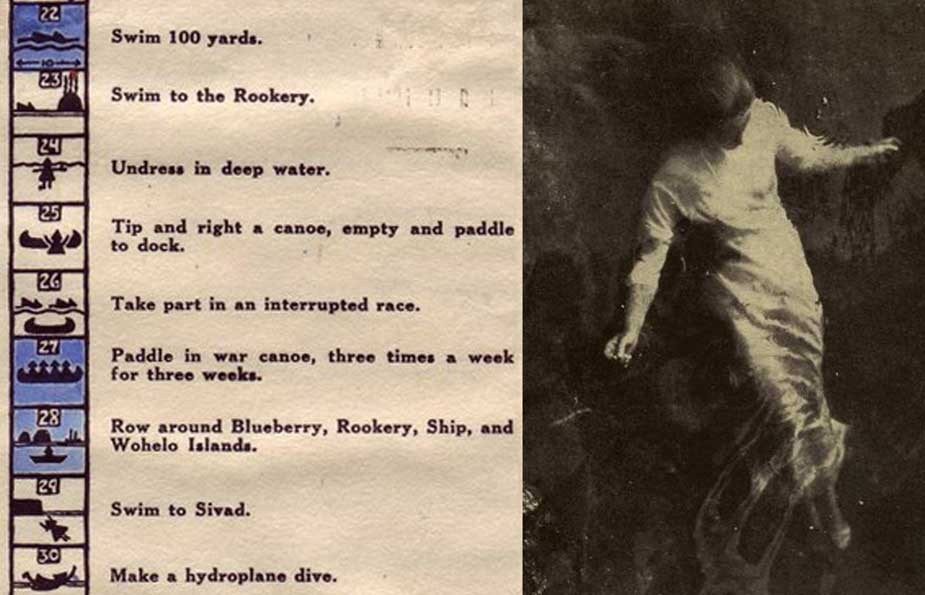
Left: example of Camp Wohelo water-related challenge symbol badges from 1920 Wohelo camp yearbook: courtesy: Gulick Family. Right: detail: full-page halftone: “Ki-lo-des-ka swimming under water” : from 1915 volume by Ethel Rogers: “Sebago-Wohelo Camp Fire Girls”
A girl swimming can not always be a creature of mystic beauty, any more than speech can always be lyric or motion be always grace. But when once the beauty in a simple act has been revealed, even in a single poetic moment, a reflected glory is thrown over the commoner moments of which this is but the type. This is the poetry that the Camp-Fire girls all over America are writing into life. (3.)
Camp Fire Girls, Basket Ball and More
Born Emma L. Vetter on Dec. 12, 1865 in Oberlin, Ohio to missionary parents, (4.) Charlotte “Lottie” Gulick was educated in Kansas public schools and undertook her secondary education at Washburn College (now Washburn University) in Topeka, Kansas doing college preparatory work. She then matriculated and earned a bachelor of arts degree from Drury College in Springfield, MO. (5.) It was at Drury that she met Luther Halsey Gulick , (1865-1918) whom she married in 1887.
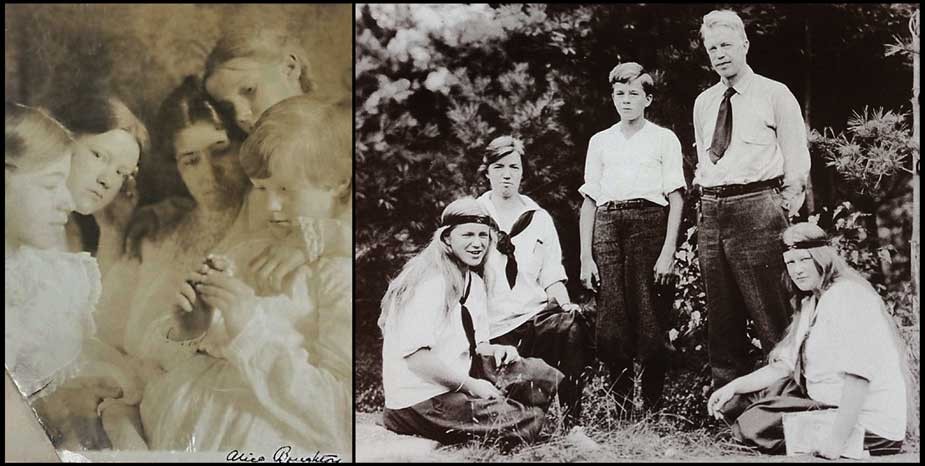
Left: photographer Charlotte Vetter Gulick is at center surrounded by her four daughters. Photograph by Alice Boughton ca. 1900. Katharine (Ki-lo-des-ka) is believed to be at right holding a flower. Reproduced later as an engraving in a New York Times article profiling the new Campfire Girls of America organization: “Girls take up the Boy Scout Idea and Band Together” (March 17, 1912) (private collection) Right: detail: members of the Gulick family from a photograph most likely taken by Charlotte Gulick around 1911. From left to right: Katharine “Kitty” Gulick (Curtis) (1895-1968); Frances “Franta” Gulick(1891-1936); Halsey Gulick; Dr. Luther Halsey Gulick (Timanous-1865-1918); Louise Gulick. (1888-1941): courtesy: Gulick Family
A strong advocate in the promotion of physical eduction as well as an organizer and author in his professional life, Dr. Luther Halsey Gulick also came from a missionary family, his father being missionary physician Luther Halsey Gulick Sr. (1828–1891) Receiving his medical degree from New York University in 1889, Dr. Gulick is perhaps best remembered today for his role in the development of the game of basketball, although this is but an interesting side story of a remarkable life. In 1891, while superintendent of the physical education department at the International YMCA Training School in Springfield, MA., (now Springfield College) he became the catalyst and inspiration for colleague James Naismith to first draw up rules for the new game of “Basket Ball”, with a peach basket nailed above the inside of a gymnasium playing court serving as the goal. His beliefs, as embodied in a poster issued after his death, were in the
“unity of body, mind and spirit, and in an education which includes all three. He devoted his life to establishing this ideal, by emphasizing the social and ethical values of physical exercise, especially through play and recreation.”
While at the YMCA, he was also responsible for designing the triangular logo which represented the YMCA philosophy of Mind, Body and Spirit. (6.)
Summer camp was an activity the Gulicks thrived on and made a lifestyle out of. Beginning in 1887, a year before their first child Louise was born, they established a camp on the shores of the Thames River in Gales Ferry CT. Co-educational, with the couples friends as well as extended Gulick family members acting as counselors to their own children and others, (7.) it operated for 20 years. In order to share what was learned to a larger audience of girls, the couple then established Camp Wohelo on Sebago Lake in 1907. An acronym comprised of the three virtues of work, health, and love, Wohelo was embodied from the start as outlined in 1915 by Charlotte Vetter Gulick:
I believe deeply and earnestly that spiritual health and development is a direct corollary of bodily vigor and control; that the joy that comes from the exercise of efficient muscles has its counterpart in the soul; that to exercise the one is to exercise the other.
Upon that rock has Wohelo been built, and its use of symbols is, perhaps, more than anything else, a working and ever-present declaration of the spiritual values inherent in all the humblest phases of our everyday life in the world. (8.)
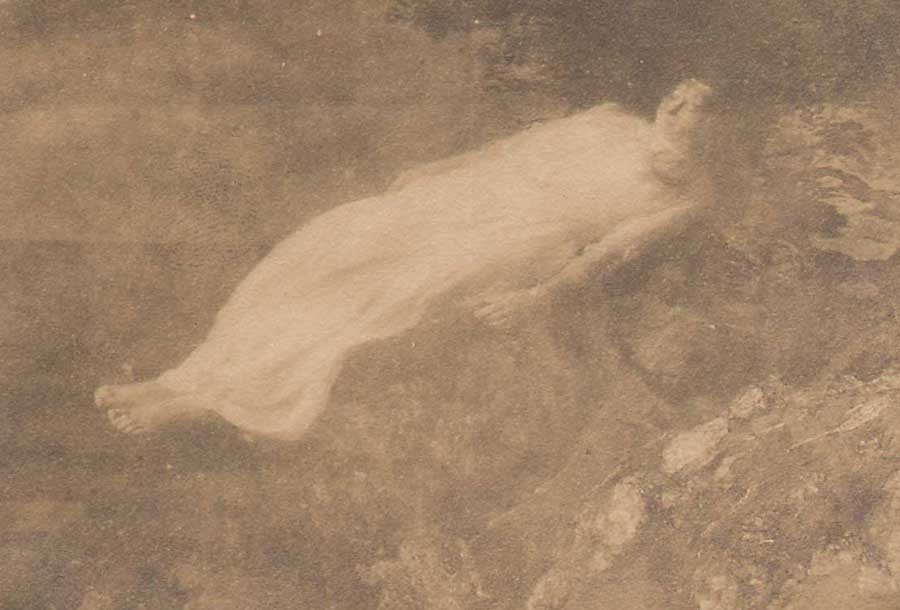
Detail: “Mermaid Study : Submerged”: Gelatin silver print: ca. 1914 or before: by Charlotte Vetter Gulick: image: 8.4 x 10.8 cm: mount: 16.7 x 22.7 cm. : reproduced as final photo for article “The Mermaid” A SERIES OF PHOTOGRAPHS BY MRS. LUTHER HALSEY GULICK: in Everybody’s Magazine: New York: August, 1914: p. 232: from: PhotoSeed Archive
Five years before this philosophy was written, in 1910, Charlotte Gulick, known by her symbolic Indian name at the Wohelo camp as Hiiteni, which translated to “Life, more life”, came up with the idea for the Camp Fire Girls movement. An organization for girls much as the Boy Scouts of America was structured for boys, and coincidentally founded the same year, Camp Fire Girls promoted all the values she and her husband had already been teaching at their earlier camp at Gales Ferry and at Wohelo:
“The idea originated in the mind of Mrs. Gulick, and was at once indorsed by Dr. Gulick, who believes it to be logical and necessary to proper development of girls amid the changing conditions of our National life.” (9.)
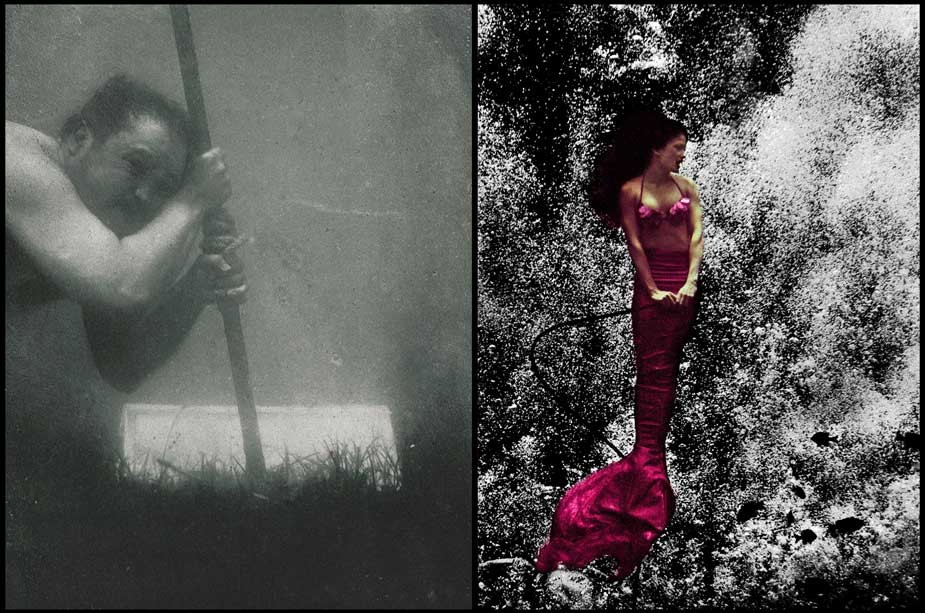
Left: detail: photo by “David”: title: “Portrait Instantané D’un Plongeur” (“Instant Portrait of a Diver”) : photogravure plate XI by Paul Dujardin showing French underwater photography pioneer Louis Marie-Auguste Boutan (1859-1934) holding himself steady underwater: from: 1900 volume “La Photographie Sous-Marine et Les Progres de La Photographie” (The Progress of Underwater Photography) (between pp. 210-211) : Gallica: National Library of France online resource. Right: a modern-day mermaid: Nicole Marino plays the starring role in “The Little Mermaid” at Florida’s Weeki Wachee Springs Waterpark. In 1947, former Navy frogman Newton Perry conceived of the idea of using an air hose and perfected “hose breathing” here. Culturally, mermaids are a tourist attraction, and have entered the popular imagination through films like “The Incredible Mr. Limpet” starring Don Knotts. (1964): 1999 photo by David Spencer/The Palm Beach Post
Today, the history of the Gulick’s shared virtues of work, health and love continue on in the summer operation of their Maine camps. In a promotional 1919 silent film on Wohelo released a year before women in the United States had the Constitutional protection of the right to vote, these changing conditions of America’s National life for young women were on display. Seated in teams of coordinated paddlers in three large over-sized canoes on Lake Sebago, the ideals of resourcefulness in working together shown in the film remains an ideal for young women still valued today.
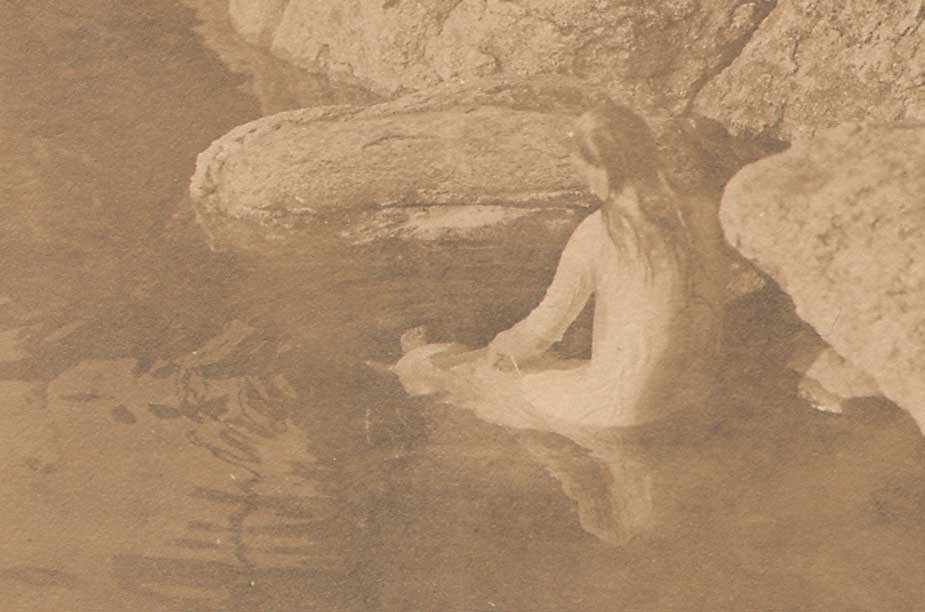
Detail: “Mermaid Sunbathing ” (“Kitty” Gulick) : Gelatin silver print: ca. 1914 or before: by Charlotte Vetter Gulick: image: 7.3 x 10.8 cm: mount: 17.0 x 22.5 cm. : In this photo, a figure study of Katharine “Kitty” Gulick by her mother, “Ki-lo-des-ka” sunbathes next to granite boulders on the Sebago Lake shoreline in Maine.: from: PhotoSeed Archive
Much like these photos of Ki-lo-des-ka the mermaid, “her yellow hair glinting golden in the sunshine” (10.) reveal beauty to us in the physical form, lines from a poem by Ralph Waldo Emerson cited by the amateur photographer Charlotte Gulick after she mastered the art of water diving at the age of 35 brings forth a desire in the human spirit to symbolically enter the depths as well:
“To vision profounder
Man’s spirit must dive.” (11.)
Notes:
1. Louis Marie-Auguste Boutan. (1859-1934) Boutan used specially-designed underwater camera housings, publishing his research conducted from 1892-1900 for a large audience in the 1900 volume “La Photographie Sous-Marine et Les Progres de La Photographie“. (The Progress of Underwater Photography)
2. from: The Mermaid: in: Everybody’s Magazine: New York: The Ridgway Company Publishers: August, 1914: p. 225
3. Ibid: pp. 225-232
4. 1870 U.S. Census. Gulick changed her name to Charlotte sometime after 1900 but was known as “Lottie”
5. Gulick background: Margaret R. and Dennis S. O’Leary: Adventures at Wohelo Camp – Summer of 1928: 2011: iUniverse: p. 24
6. 1921 poster of Luther Halsey Gulick: Makers of American Ideals poster issued by the National Child Welfare Association: Springfield College Digital online resource accessed Oct., 2014
7. background: Camp Timanous website accessed Oct., 2014. Owned by the Suitor family since the 1930’s, the camp was originally founded by Luther Halsey Gulick in 1917, whose symbolic Indian name Timanous– was “Guiding Spirit“. In the introduction to the 1915 Sebago-Wohelo Camp Fire Girls volume, Charlotte Gulick states as many as 75 people camped together at Gales Ferry before Wohelo was established.
8. excerpt: Introduction: Mrs. Luther Halsey Gulick: Ethel Rogers: Sebago-Wohelo Camp Fire Girls: Battle Creek, MI: Good Health Publishing Company: 1915: pp. 22-23
9. excerpt: Girls Take up the Boy Scout Idea and Band Together: Edward Marshall: in: The New York Times: March 17, 1912
10. Sebago-Wohelo Camp Fire Girls: p. 94
11. Ibid: p. 22
: and of course I’m happy to be corrected
Walt Whitman certainly did. Just check out his eyeballs on this photograph taken in 1887 by George C. Cox for confirmation. Especially on this most personal of American holidays, the Fourth of July, the continuing birthday idea of our messy, evolving experiment of a democratic republic called the United States can never be said to be boring.
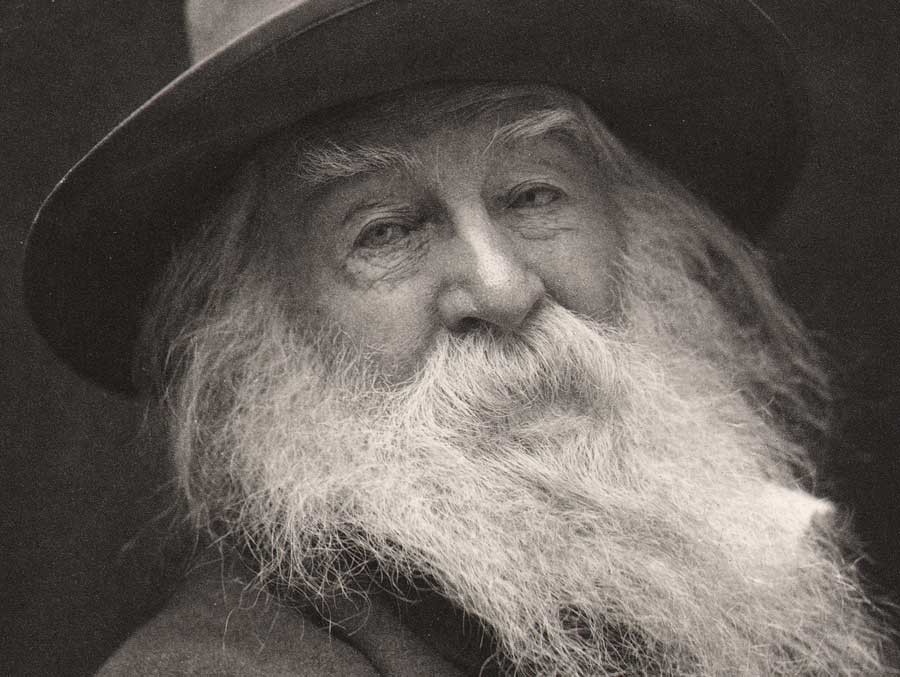
Detail: 1887: Walt Whitman-1819-1892 by George C. Cox: (portrait known as the “Laughing Philosopher”) 23.9 x 18.8 cm | 45.2 x 33.3 cm: vintage large format, hand-pulled photogravure printed circa 1905-10 by the Photographische Gesellschaft in Berlin on Van Gelder Zonen plate paper. From: PhotoSeed Archive
Need proof of his vision? – Whitman’s metaphorical call in this famous quote: “What is that you express in your eyes?” ; and response: “It seems to me more than all the print I have read in my life.”
You could say America’s poet (1819-1892) of the everyman didn’t need a camera, he was one. His genius of observation, something all great photographers possess, gave him the power to indelibly express his convictions. So when words flowed from his pen, they possessed the power of photographs, especially on the very idea of America in the aftermath of the Civil War:
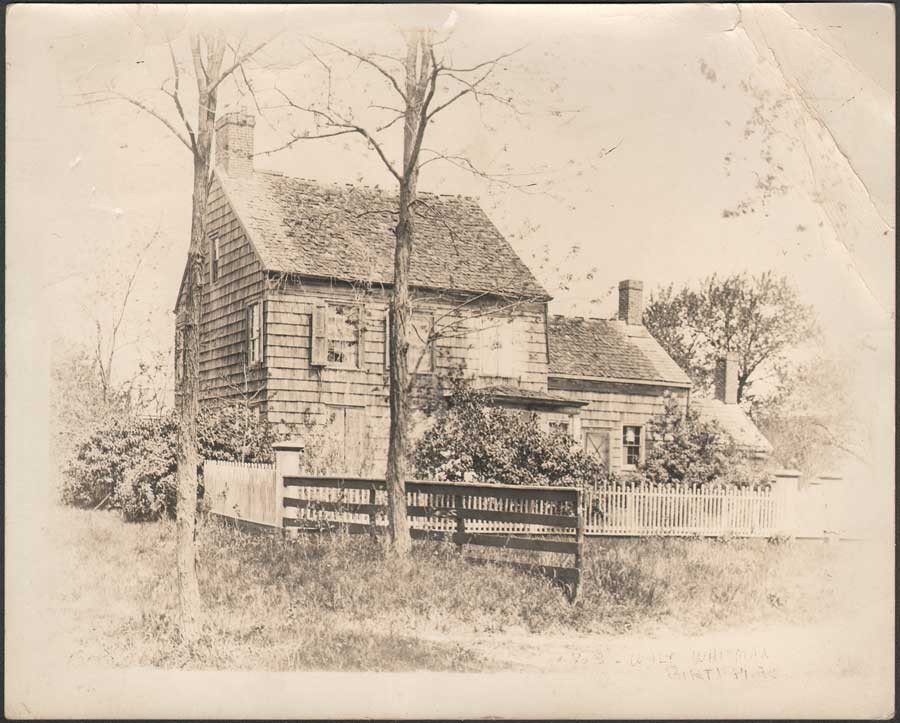
“Walt Whitman Birthplace in 1903” (South Huntington, New York): by Ben Conklin: 1903: vintage albumen print: 20.3 x 25.2 cm from: PhotoSeed Archive: (Benjamin Sargent Conklin: 1873-1964)
from Leaves of Grass: intro to “Thoughts“:
Of these years I sing,
How they pass and have pass’d through convuls’d pains, as
through parturitions,
How America illustrates birth, muscular youth, the promise, the
sure fulfilment, the absolute success, despite of people-
illustrates evil as well as good,
The vehement struggle so fierce for unity in one’s-self;
How many hold despairingly yet to the models departed, caste,
myths obedience, compulsion, and to infidelity, … (1.)
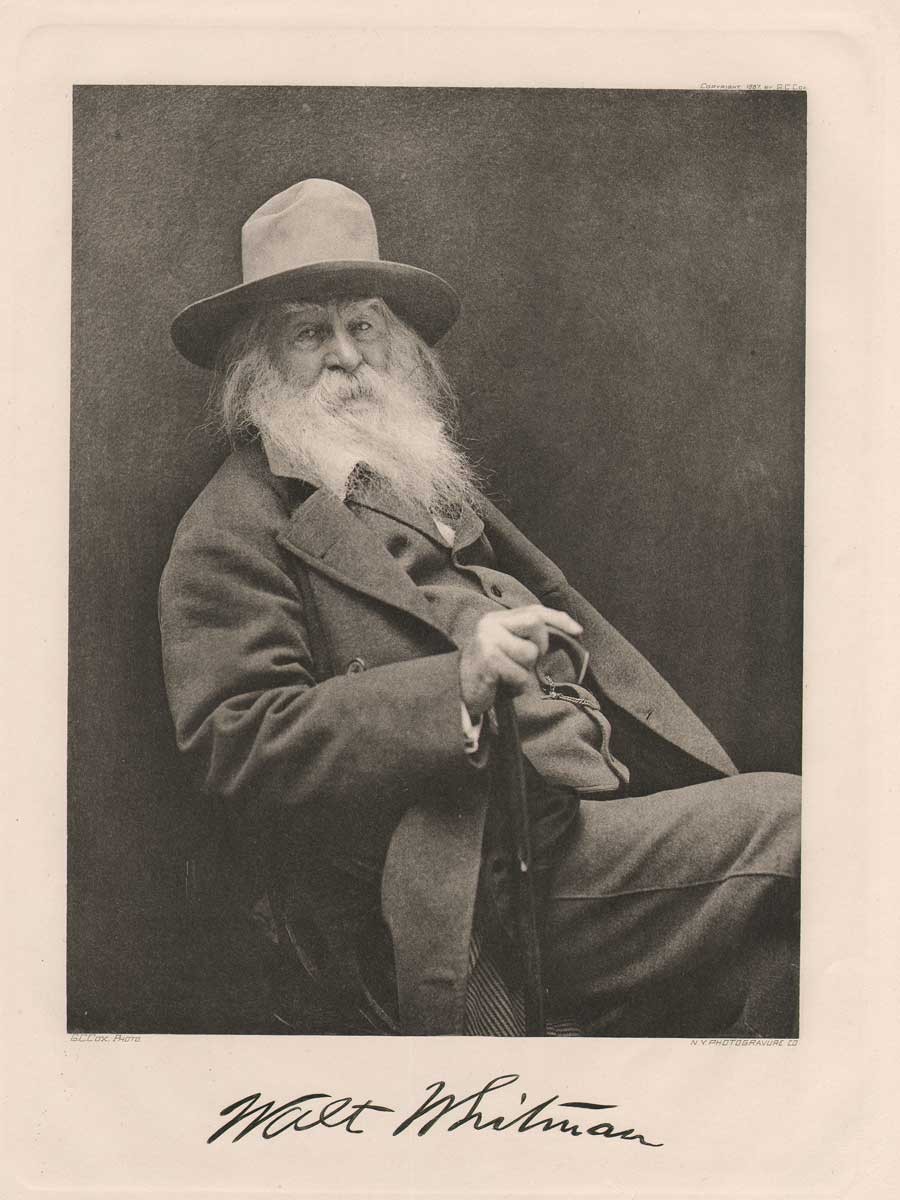
“Walt Whitman” by George C. Cox: 1887. Hand-pulled photogravure published in periodical “Sun & Shade” New York: March, 1892: whole #43: N.Y. Photogravure Co.: 21.5 x 16.7 cm | 34.7 x 27.4 cm: from: PhotoSeed Archive
But enough of the history lesson. Since most of us will never rise to the level of a Whitman in prose, photography as an art form is a comparably easy stretch. Speaking for myself as a young newspaper photographer in the mid 1980’s hunched over a light table editing film, an early mentor told me as long as a person’s eyes in the negative were tack sharp through the loupe, it was a “keeper”, and worthy of publication.
And so it was for my colleagues a century before my own light table revelation, but with the slow, fragile dry plates in use at the time a much greater technical challenge. In 1887, New York portrait photographer George Collins Cox (1851-1902) had the sitting of a lifetime in none other than Whitman. Strolling into his New York studio with oversized fedora, it was 22 years to the day no less on April 15th when American president Abraham Lincoln finally succumbed to an assassin’s bullet in 1865.
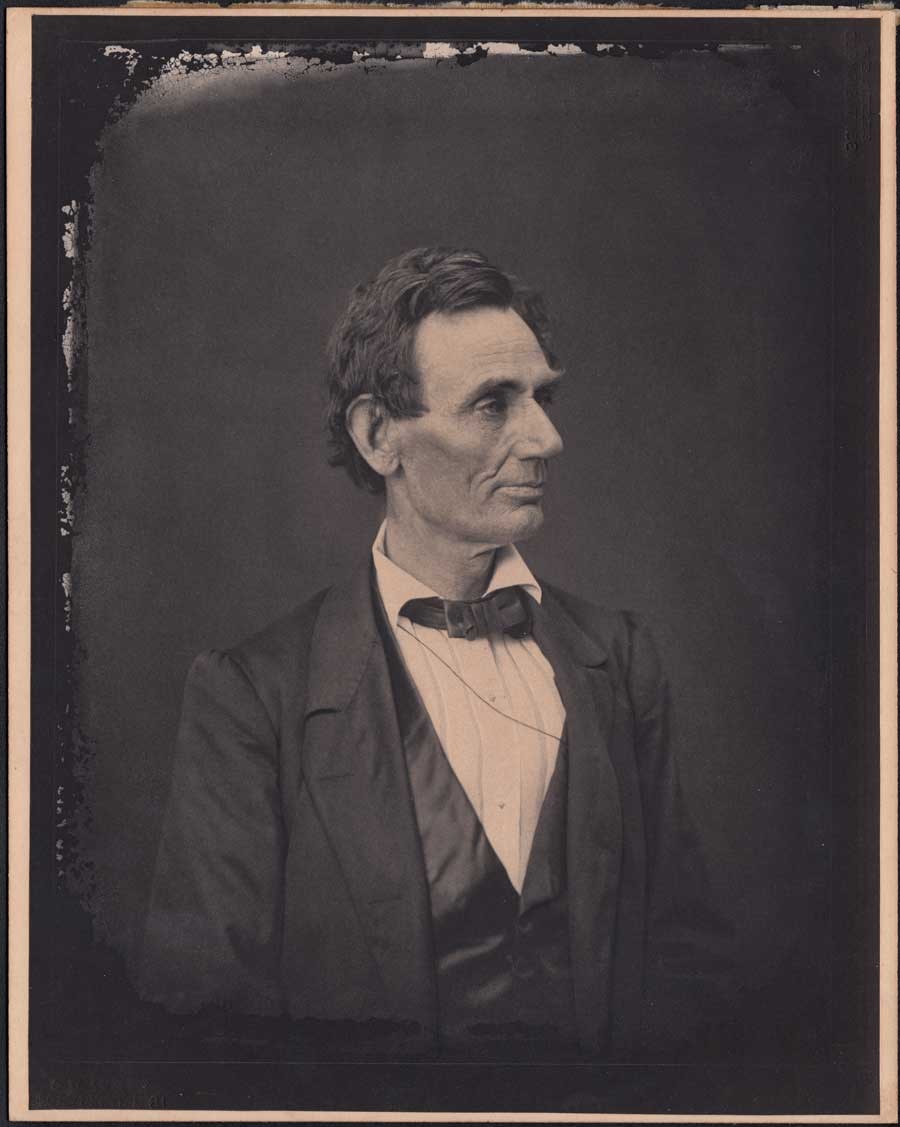
Abraham Lincoln by Alexander Hesler (1823-July 4th, 1895):taken in Springfield, Illinois on June 3, 1860: vintage platinum print © 1881 by George Bucher Ayres: print from late 1890’s: Meserve #26|Ostendorf #26″ One of the most famous Walt Whitman poems, “O Captain! My Captain!”, eulogizing the death of this American president, was written by Whitman in 1865: from: PhotoSeed Archive
And he nailed it, as they say in America. Eyes tack sharp. The following historical account of the Whitman portrait sitting from the Charles E. Feinberg Collection at the Library of Congress gives a nice working account of Cox the photographer in action. A result of that session: the “Laughing Philosopher“, was the title Whitman declared as his favorite:
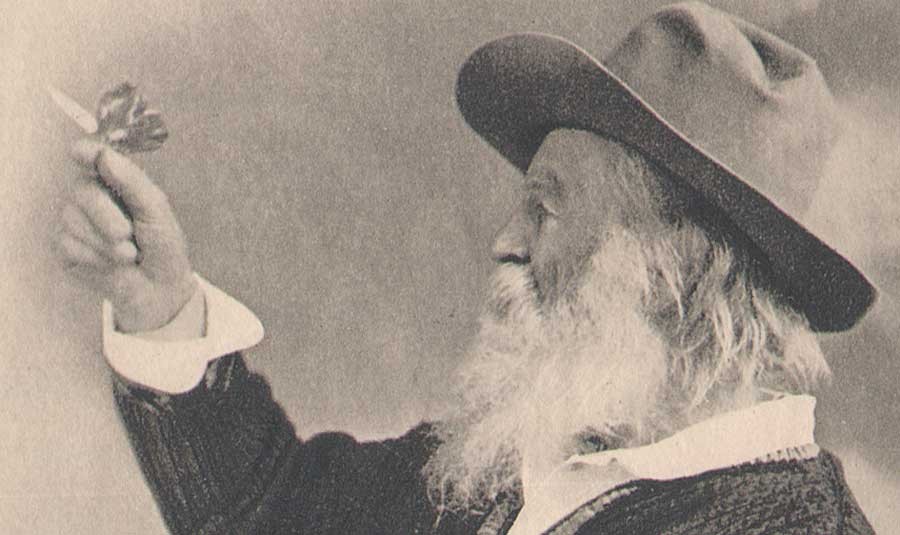
Detail: “Walt Whitman and the Butterfly” :1877(?):by W. Curtis Taylor of Broadbent & Taylor (Philadelphia): vintage hand-pulled vellum photogravure: 13.8 x 9.8 cm | 22.6 x 15.0 cm: from: Leaves of Grass II: The Complete Writings of Walt Whitman: New York:1902: Henry W. Knight:National Edition limited to 500 copies:”In fact, the “butterfly” was clearly a photographic prop now in the collections of the Library of Congress. The die-cut cardboard butterfly is imprinted with the lyrics to a John Mason Neale hymn and the word “Easter” in large capital letters.”… What is not often noted is that the photo simply enacts one of the recurrent visual emblems in the 1860 edition of Leaves: a hand with a butterfly perched on a finger. …”The butterfly . . . represents, of course, Psyche, his soul, his fixed contemplation of which accords with his declaration: ‘I need no assurances; I am a man who is preoccupied of his own soul.'”- The Walt Whitman Archive online resource- from: PhotoSeed Archive
“On the morning of April 15th, 1887, George Cox took several photographs of Whitman, who was celebrating the success of his New York lecture on Lincoln, delivered the day before. Whitman recalls that “six or seven” photos were made during the session, but Whitman’s friend Jeannette Gilder, an observer of the session, said there were many more than that: ‘He must have had twenty pictures taken, yet he never posed for a moment. He simply sat in the big revolving chair and swung himself to the right or to the left, as Mr. Cox directed, or took his hat off or put it on again, his expression and attitude remaining so natural that no one would have supposed he was sitting for a photograph.” (2.)
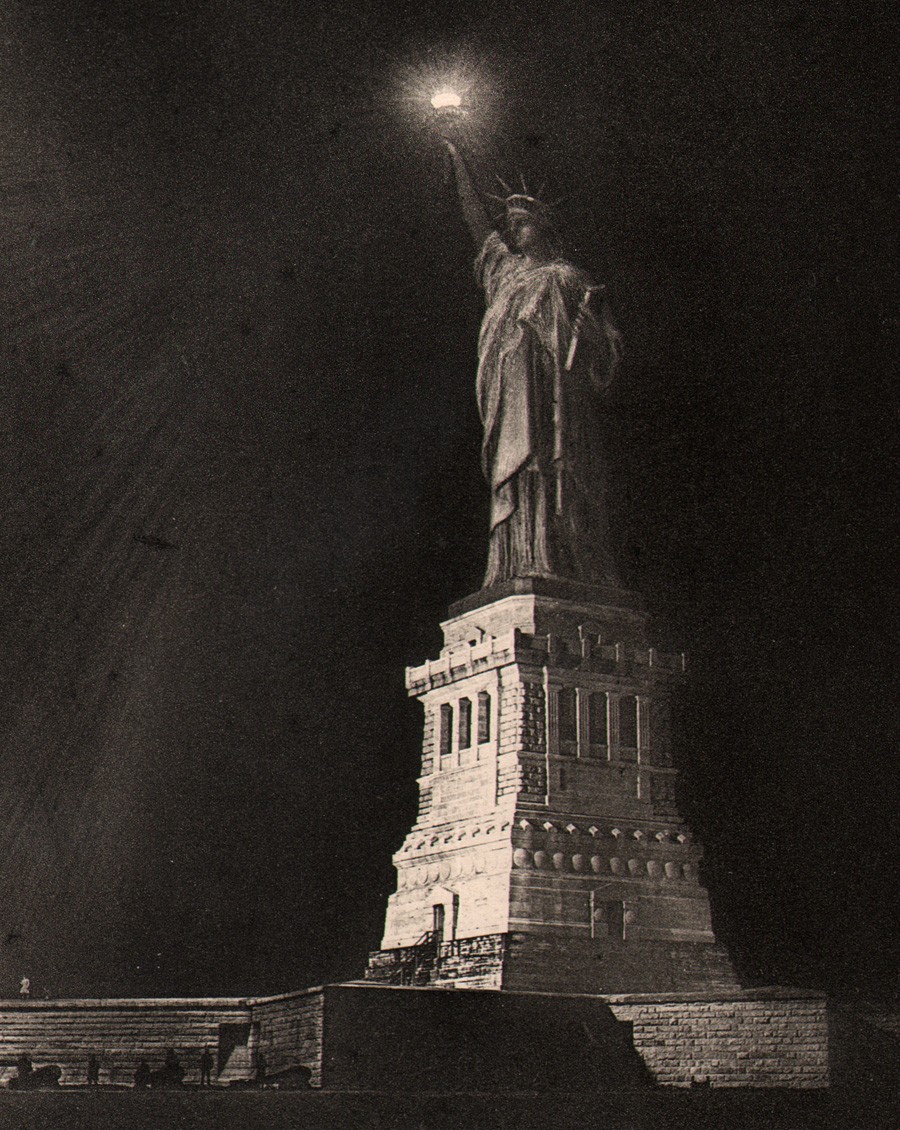
Detail: “Statue of Liberty at Night”: Seneca Ray Stoddard: Hand-pulled photogravure published in periodical “Sun & Shade” New York: September, 1890: whole #25: N.Y. Photogravure Co.: 18.5 x 12.0 cm 35.2 cm x 27.6 cm: For many, the dream of America still holds true in the light, or darkness, of Lady Liberty’s torch-even when viewed against the backdrop of the messy, evolving experiment of a democratic republic called the United States- one fully embraced in the writings of Walt Whitman. A technical description of this photograph copyrighted in 1889 by Stoddard: “Mr. Stoddard employed five cameras on this occasion, stationing them on the Steamboat Pier. A wire was stretched from the torch of the Statue to the mast of a vessel a considerable distance away. Placed on this wire, controlled by a pulley, was a cup containing one and one-half pounds of flash powder; an electric wire was connected with it, and at a given signal the current turned on, by the electrician in charge of the torch, the flash exploded and the exposure made.” from: PhotoSeed Archive
1. from “Thoughts” Leaves of Grass II: The Complete Writings of Walt Whitman: New York:1902: Henry W. Knight, publisher: National (limited) Edition: p. 275
2. excerpt: Walt Whitman Archive online resource accessed July, 2014
When evaluating the chiaroscuro masterpiece Campo San Margherita by James Craig Annan, a striking vertical composition taken in 1894 during his visit to the Campo San Margherita piazza in Venice-an outdoor market and tourist destination still popular today- the idea of Modernism, a decidedly 20th Century school as applied to the photographic arts, should be taken seriously considering the intent and evidence posed by this finished work.

Detail: “Campo San Margherita”: vintage hand-pulled photogravure by James Craig Annan published in Bulletin de l’Association Belge de Photographie: June, 1897: image: 15.0 x 5.1 cm: laid paper support: 22.6 x 15.0 cm: from PhotoSeed Archive
Documentary, cubist in form and radically pictorial for its time, this slice of life study showing the interaction of a market vendor and customer can be dissected for compositional posterity with the intent a post-mortem of sorts by this reviewer is reason enough when re-considering the historical record of early photographic aesthetics.
First off, Scotsman Annan was a master engraver and pioneer of the hand-pulled photogravure, an intaglio process similar to etching, but with the matrix of a photographic negative “from life” doing the stand-in for the artists brush or pencil. With this control afforded, the photographic results transferred to a copper plate could be altered at will depending on artistic intent, giving Annan the ability to subtly control and change aspects of his composition after he took the initial exposure by camera.
Arbitrarily beginning at the bottom of the frame, a subtle flow begins to develop reaching near the top of this composition. Here we see the Campo San Margherita title, with letters spanning the entire width of the vertical composition placed in its own compartmentalized box serving as anchor to the entire work.

Detail: title: “Campo San Margherita”: vintage hand-pulled photogravure by James Craig Annan published in Bulletin de l’Association Belge de Photographie: June, 1897: image: 15.0 x 5.1 cm: laid paper support: 22.6 x 15.0 cm: from PhotoSeed Archive
From here, the eye travels upwards. With an engraver’s burin, Annan deliberately alters a portion of highlighted marketplace cobblestones to a shaded version- the result being complimentary, contrasting diagonals now taking residence within the dead-zone of space created by his decision to present the work as an extreme vertical composition from the outset.
This in turn brings us to the very center of the frame. Without reading too much into it, the scale itself is the perfect symbol for what Annan achieves in this area we are most interested in visually. Holding it out while weighing a marketplace purchase for his customer opposite, the vendor’s action gives credibility to the idea a kind of balance has been created and achieved at the very center of the frame, especially after she conveniently stoops to his same level while contemplating the purchase.
The rest of the frame serving as backdrop to this drama in the middle compliments everything else within in, but with a twist. Instead of a purely static presentation of a lone moment occurring in the marketplace, the hat-wearing gentleman walking directly behind the vendor preparing to bust out of the frame gives a refreshing jolt to the work. Annan’s inclusion of this other action reminds us the marketplace bustles with life.
Finally, the central part of the background: a large shaded alleyway dividing two separate buildings anchoring the entire left and right margins of the frame, neatly compliments the balance of the two windows seen behind the man wearing the hat. Here, the area of the arched window frame in the top left of the composition reaches upwards to its natural conclusion: another area of naturally shaded discoloration similar in tone and effect Annan manipulated for the bottom third of the frame.
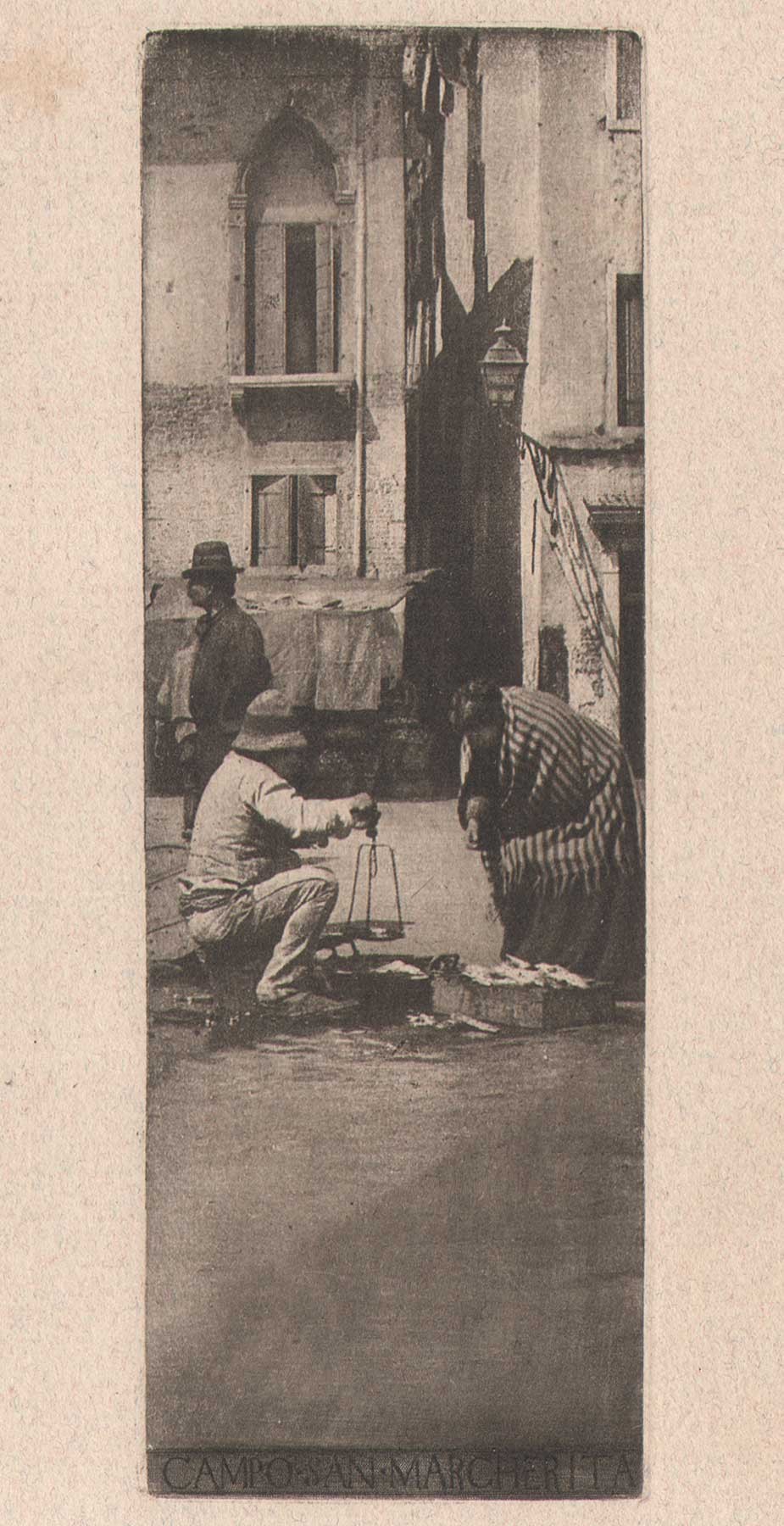
“Campo San Margherita”-cropped to include part of margins: vintage hand-pulled photogravure by James Craig Annan published in Bulletin de l’Association Belge de Photographie: June, 1897: image: 15.0 x 5.1 cm: laid paper support: 22.6 x 15.0 cm: from PhotoSeed Archive
But this is just one opinion, albeit from someone who has spent a lifetime constructing and deconstructing photographs. Hopefully, this insight into one singular example of Annan’s art might give others the chance to see his motives and intent for what they are: a strong example of photographic Modernism ahead of his time.
David Spencer-